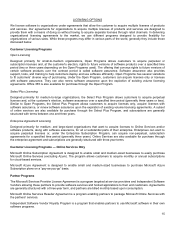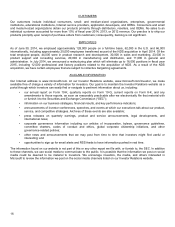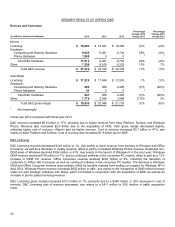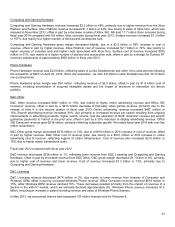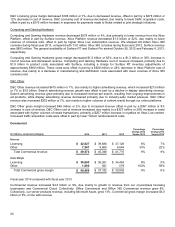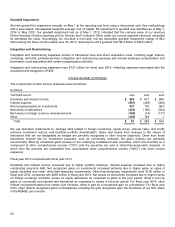Microsoft 2014 Annual Report Download - page 21
Download and view the complete annual report
Please find page 21 of the 2014 Microsoft annual report below. You can navigate through the pages in the report by either clicking on the pages listed below, or by using the keyword search tool below to find specific information within the annual report.20
Reportable Segments
The segment amounts included in MD&A are presented on a basis consistent with our internal management reporting.
Segment information appearing in Note 21 – Segment Information and Geographic Data of the Notes to Financial
Statements is also presented on this basis. All differences between our internal management reporting basis and
accounting principles generally accepted in the U.S. (“U.S. GAAP”), along with certain corporate-level and other activity,
are included in Corporate and other. Operating expenses are not allocated to our segments.
During the first quarter of fiscal year 2014, we changed our organizational structure as part of our transformation to a
devices and services company. As a result, information that our chief operating decision maker regularly reviews for
purposes of allocating resources and assessing performance changed. Therefore, we have recast certain prior period
amounts to conform to the way we internally managed and monitored segment performance during fiscal year 2014. Our
reportable segments are described below.
On April 25, 2014, we acquired substantially all of NDS for total consideration of $9.5 billion. This amount was greater
than the $7.2 billion disclosed previously, primarily due to $1.5 billion of cash acquired, foreign currency movements of
$330 million, working capital adjustments of $210 million, and other adjustments of $260 million. See Note 9 – Business
Combinations of the Notes to Financial Statements for additional details. NDS has been included in our consolidated
results of operations starting on the acquisition date. We report the financial performance of the acquired business in our
new Phone Hardware segment. Prior to the acquisition of NDS, financial results associated with our joint strategic
initiatives with Nokia were reflected in our D&C Licensing segment. The contractual relationship with Nokia related to
those initiatives terminated in conjunction with the acquisition. With the creation of the new Phone Hardware segment, the
D&C Hardware segment was renamed Computing and Gaming Hardware in the fourth quarter of fiscal year 2014.
Devices and Consumer (“D&C”)
Our D&C segments develop, manufacture, market, and support products and services designed to entertain and connect
people, increase personal productivity, help people simplify tasks and make more informed decisions online, and help
advertisers connect with audiences. Our D&C segments are:
• D&C Licensing, comprising: Windows, including all OEM licensing (“Windows OEM”) and other non-volume
licensing and academic volume licensing of the Windows operating system and related software; non-volume
licensing of Microsoft Office, comprising the core Office product set, for consumers (“Office Consumer”);
Windows Phone operating system, including related patent licensing; and certain other patent licensing
revenue;
• Computing and Gaming Hardware, comprising: Xbox gaming and entertainment consoles and accessories,
second-party and third-party video game royalties, and Xbox Live subscriptions (“Xbox Platform”); Surface
devices and accessories; and Microsoft PC accessories;
• Phone Hardware, comprising: Lumia Smartphones and other non-Lumia phones, beginning with our
acquisition of NDS; and
• D&C Other, comprising: Resale, including Windows Store, Xbox Live transactions, and Windows Phone Store;
search advertising; display advertising; Office 365 Consumer, comprising Office 365 Home and Office 365
Personal; Studios, comprising first-party video games; our retail stores; and certain other consumer products
and services not included in the categories above.
Commercial
Our Commercial segments develop, market, and support software and services designed to increase individual, team,
and organizational productivity and efficiency, including simplifying everyday tasks through seamless operations across
the user’s hardware and software. Our Commercial segments are:
• Commercial Licensing, comprising: server products, including Windows Server, Microsoft SQL Server, Visual
Studio, System Center, and related Client Access Licenses (“CALs”); Windows Embedded; volume licensing of
the Windows operating system, excluding academic (“Windows Commercial”); Microsoft Office for business,
including Office, Exchange, SharePoint, Lync, and related CALs (“Office Commercial”); Microsoft Dynamics
business solutions, excluding Dynamics CRM Online; and Skype; and
• Commercial Other, comprising: Enterprise Services, including Premier Support Services and Microsoft
Consulting Services; Commercial Cloud, comprising Office 365 Commercial, other Microsoft Office online
offerings, Dynamics CRM Online, and Microsoft Azure; and certain other commercial products and online
services not included in the categories above.







